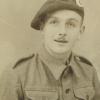Sgt Callaway was one of 17 NCOs who left Company Headquarters on 13 July 1943 for the airborne landings on Sicily. The objective was to take the Primosole Bridge crossing the River Simeto south of Catania. In his subsequent report he recorded:
“Sir, I have to report that on the 11th July 1943, Cpl Strand, L/Cpls Watson, Buttery, James, Barlow and myself were attached to the 3rd Parachute Battalion for operations. We were briefed on the whole operation and our role as Military Policemen. We were dropped on the night of 13th July. The plane was caught in searchlights and there was also very heavy anti-aircraft fire. Whilst jumping, tracer bullets came at us from all directions.
On reaching the ground it was obvious that we had been dropped on the wrong DZ and were in the middle of a well defended enemy location. I realised that my role as a Military Policeman was finished and I therefore adopted that of a parachutist. On the DZ I made my way to where the containers should have been, and I picked up my NCOs. We crossed a river and on the other side I made contact with 7 paratroopers from the 3rd Battalion. There was no sign of Lt Mansfield or the Section Sergeant. Fires were burning all around us and machine gun fire and shots were coming from all directions. Several screams were heard coming from the direction of the fires.
We saw a C47 Dakota caught in heavy anti-aircraft fire, burst in to flames and lose height rapidly. Two parachutes opened and appeared to come down with the plane. Realising that there was nothing we could do at that time I made a mental note of the location of the plane for future identification. We continued to make our way across country until we came to a large shell hole. We had no sooner taken cover when we saw a plane and glider crash in the distance. I asked for three volunteers for a Patrol to get the lay of the ground and also to do anything possible for the occupants of the plane and glider. The Patrol consisted of L/Cpls Buttery and Watson and Pte Easton of The Parachute Regiment. I told them that the rest of us would remain in our present position until the moon went down.
Later we heard shots coming from the direction the Patrol had taken and, after waiting until the agreed time we moved our position. We made for the river, found cover, and rested for the day. Later one of the sentries pointed out to me a German patrol with two Airborne prisoners. I also saw TCVs carrying German infantry, also tanks, presumably Herman Goering P IVs, advancing east along the road approximately 200 yards to our front.
Later we tried without success to make our way to the bridge which was the original objective. After a further two days of hiding we decided to split into small groups and attempt to make our way back to Allied lines, doing whatever damage we could wherever possible. We left at intervals in twos and threes. I was with Ptes Stansbury and Smallman of The Parachute Regiment.
Time elapsed and we were getting very tired and hungry. We came to a farmhouse and decided to attack it as our hunger was getting the better of us. We rushed the farmhouse but were amazed to find six Sicilians inside who welcomed us with open arms. There we ate and slept in rotation. During this time planes were passing overhead and bombing about 600 yards west of the farm. We learnt from the Sicilians that it was an Italian airfield.
We left that night and made for the airfield to do whatever damage we could. We fired two planes and then got out as quickly as possible. We met no opposition but made it a very short stay as we had seen German patrols in the vicinity during the day.
For two days we carried on hiding and crawling and infiltrating. We came across a crashed and burnt out aircraft which appeared similar to a C47. All the occupants were burnt beyond recognition. We could not get any identity discs off the bodies as it would have meant digging in the debris and shifting the whole lot which was unsafe as we were not far from the main road. We found a body which appeared to be that of the pilot approximately 20 yards from the plane. The only identification we could find of the aircraft was a small container with six black stripes and the number ‘12’ on it. I would estimate that there were about 10 bodies in the wreckage.
The following day we met up with a unit of the 8th Army to whom I gave all the information we had gathered. After resting and eating we were taken to Syracuse and from there to Malta where we were re-clothed and taken by ship to Suez.
By Sgt H Callaway
In The Field
27 July 1943.
By Sgt 'Cab' Callaway
Read More



Latest Comments
There are currently no comments for this content.
Add Comment
In order to add comments you must be registered with ParaData.
If you are currently a ParaData member please login.
If you are not currently a ParaData member but wish to get involved please register.